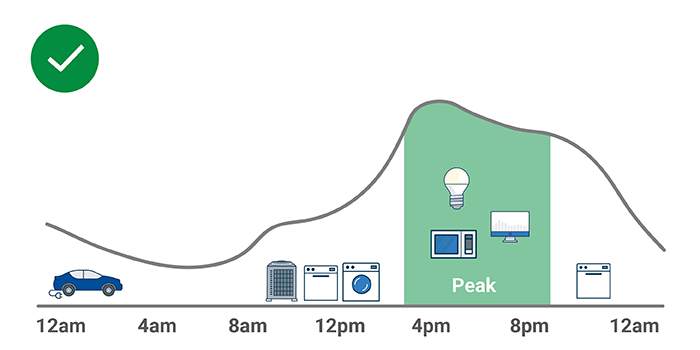Summer Peak Time Based Plan
Only has peak pricing during the summer months.
Avoid peak hours on summer weekdays and pay about 2/3 less
The Summer Peak Time Based Plan (formerly called the Standard Peak Saver plan) features 2 time periods in the summer (peak and off-peak) and 2 time periods in non-summer months (off-peak and super off-peak), and there are no peak periods on holidays. Ver información en español.
To view state-specific rate information for this plan, please log in to your Evergy account.
To avoid paying a higher price for energy during the summer peak period, it's smart to shift energy usage to mornings, overnight or weekends from June-Sept. The peak price occurs only during the summer months and is about four times as much as the off-peak rate.
Not ready to switch to this plan? Use your Rate Comparison Tool to find out which plan best fits your household.
 |
We're here to helpHow to save on this plan?
If you enjoy using smart home products, like a smart thermostat or programmable appliances, and already pay attention to your energy usage, this rate option makes it even easier for you to save energy and schedule around peak hours. Let's breakdown how time-based plans work: Ver en español (solo para Misuri) Savings level In the summer: During other months: |
Avoid peak hours by spreading out energy use on weekdays
Energy use is at its highest between 4-8 pm (peak hours) on the weekdays, which is why timing is everything when it comes to energy costs. Because we're able to match the cost you pay with actual costs to produce energy, you can save the most when you avoid peak times on weekdays (because that's when energy production is at its highest, like a "rush hour").
Helpful saving tipsWe want to offer helpful tips and savings information along the way. Here are some smart ways to save on this plan and make sure it fits with your lifestyle! Laundry: Wash clothes on cold—they get just as clean and save energy. You can also run your dryer later on weekday evenings or anytime on the weekends and holidays to avoid 4-8 pm peak prices. Dishwashing: Run full loads and wait until peak summer hours end on weekdays (or anytime on weekends). Cooling: Set your thermostat to cool your home a few degrees lower before peak hours begin. It's also helpful to turn your thermostat a few degrees higher during peak hours on weekdays. With this plan, we’ll email you weekly coaching reports to show how you’re doing (with even more saving tips). You can also view your online personalized energy management dashboard anytime for a deeper understanding of when your usage is highest and what uses the most energy in your home. |
Other plan options


